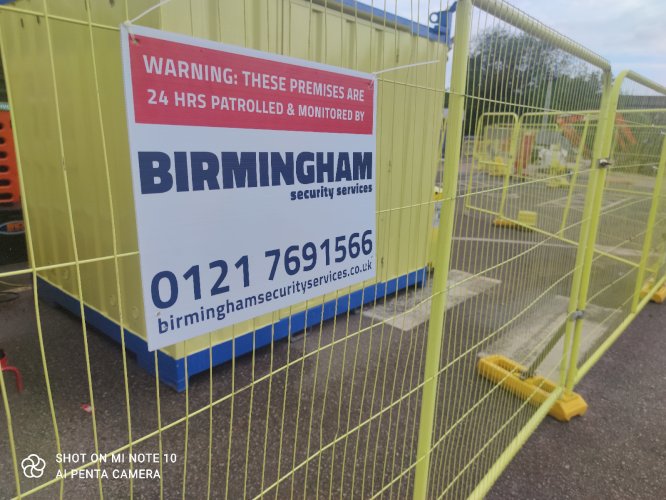Construction Site Security: How to Protect Your Project, Assets, and Workforce
1 month ago - 4 min read
Construction sites are dynamic and full of progress, but they also present serious security risks. With valuable machinery, expensive materials, and limited supervision after hours, these sites are prime targets for theft, vandalism, and trespassing. This guide explains why construction site security is essential, what makes sites vulnerable, and the best strategies to safeguard your project from costly disruptions.
Why Construction Site Security Matters
1. Growing Theft and Vandalism
Construction-related theft costs the industry over $1 billion annually. Tools, copper wiring, and heavy machinery are attractive to criminals, particularly during economic downturns. Open layouts, poor lighting, and minimal night supervision make it easy for intruders to strike unnoticed.
2. Project Delays and Financial Loss
A single security breach can halt operations, delay timelines, and damage budgets. Replacing stolen materials, repairing vandalized property, and processing insurance claims can overwhelm project managers. Effective construction site security ensures work continues smoothly without costly interruptions.
3. Legal and Insurance Risks
Failing to secure a site can result in denied insurance claims or legal penalties. Many insurers and regulatory bodies require proof of adequate fencing, alarms, and monitoring systems. Demonstrating due diligence through strong site security reduces liability and strengthens compliance.
Why Construction Sites Are Vulnerable
Understanding why sites attract criminals helps you build better defences:
- Unattended Tools and Equipment: High-value machinery left in open areas is easy to steal or resell.
- Valuable Materials in Plain Sight: Copper pipes, timber, and other resources are often left exposed, making them easy targets.
- Weak Lighting and Perimeter Control: Dim or unsecured boundaries encourage trespassing and theft.
Key Principles of Effective Construction Security
Visibility and Deterrence
Criminals avoid sites that look secure. Install CCTV cameras, bright LED lighting, and warning signage to create an environment where intruders think twice.
Access Control
Limit entry to authorised personnel only. Use ID badges, keypads, or biometric scanners to track who enters and exits. This reduces unauthorised access and improves accountability.
Rapid Response and Monitoring
Round-the-clock monitoring—whether on-site or remote—helps detect and respond to threats immediately before serious loss occurs.
Best Construction Site Security Measures
1. Surveillance Systems (CCTV, Drones, Remote Monitoring)
Modern CCTV systems with night vision and remote access provide 24/7 visibility. Drones can monitor large or complex sites from above, while remote monitoring services ensure fast response to any suspicious activity.
2. Access Control Systems
ID badges, keycards, and biometric gates prevent unauthorised entry and maintain a record of who is on-site. This not only enhances safety but also helps with compliance tracking and incident investigations.
3. Perimeter Security (Fencing, Barriers, Lighting)
A strong perimeter is your first defence line. Use anti-climb fencing, locked gates, and motion-activated lighting to deter intruders and reduce liability.
4. On-Site Security Guards
Trained guards provide human oversight that technology alone can’t match. They can patrol the site, verify IDs, monitor cameras, and respond immediately to alarms or incidents.
5. Alarm and Motion Detection Systems
Wireless alarms with motion, door, and glass-break sensors alert you to intrusions instantly. When combined with CCTV, they create an effective layered defence.
6. Smart Sensors and IoT Integration
IoT-enabled devices like GPS trackers, smart locks, and environmental sensors offer real-time updates on site conditions. They can detect theft, equipment misuse, or environmental risks like fire or flooding.
7. Equipment Tracking and Inventory Management
Tagging equipment with GPS or barcodes helps prevent theft and improves accountability. These systems provide proof for insurance and help identify lost or stolen assets quickly.
8. Warning Signage and Zero-Tolerance Policies
Visible warning signs reinforce that the site is protected and monitored. Combine this with strict enforcement policies for trespassing, theft, and safety violations.
9. Insurance and Risk Planning
Even the best security plan needs a safety net. Regularly review insurance policies and conduct risk assessments as your project evolves to ensure full protection.
Strengthening Construction Site Security Over Time
Conduct Regular Risk Assessments
Evaluate vulnerabilities such as weak access points, poor lighting, or outdated equipment. Reassess after major site changes or expansions.
Train and Engage the Workforce
Security is everyone’s responsibility. Train staff and contractors to report suspicious activity, lock up tools, and follow safety protocols.
Adapt to Site Changes
Security needs evolve as projects progress. Update your plans regularly to address new risks or changes in crew size, layout, or equipment storage.
Partnering with Construction Site Security Experts
Hiring a professional construction security company can save time and money while ensuring full compliance.
How to Choose the Right Provider:
- Look for proven experience in construction environments.
- Ensure they offer 24/7 support and scalable solutions.
- Verify staff training, response times, and customer feedback.
Benefits of Managed Security Services:
Outsourced monitoring, reporting, and system maintenance allow project managers to focus on deadlines while experts handle protection.
Tailored Security for Every Site:
Urban sites may face vandalism or protest risks, while rural areas require remote surveillance and rapid response planning. A customised approach ensures effective protection at the right cost.
Conclusion
Strong construction site security isn’t just about protecting materials—it’s about keeping projects on track, workers safe, and budgets under control. By combining surveillance, access control, lighting, and trained personnel, you can transform a vulnerable construction zone into a well-protected site.
Proactive security planning today prevents losses tomorrow.
FAQs about Construction Site Security
What are construction site security measures?
They include CCTV surveillance, fencing, alarms, access control, lighting, on-site guards, and equipment tracking systems designed to deter theft and prevent unauthorised entry.
Who is responsible for construction site security?
The general contractor or site manager usually oversees site security, but property owners, subcontractors, and security providers also play key roles in maintaining protection.
Why is construction site security important?
Effective site security prevents theft, vandalism, and delays while protecting workers and ensuring compliance with insurance and safety regulations.